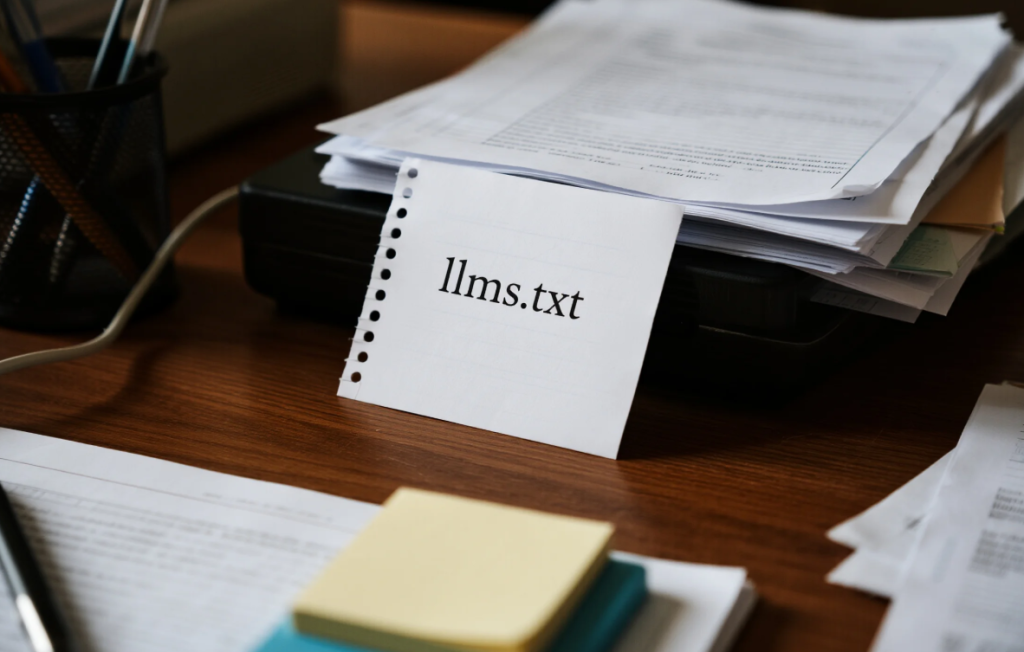Have you ever seen a reference to llms.txt and wondered why so many AI tools mention it? At first glance, it looks like just another plain text file. Yet, it quietly controls how large language models interpret instructions, access data, or even respect usage rules. In other words, it acts like a rulebook for machines.

But how exactly does it work? More importantly—how do you create one the right way?
Let’s break it down step by step.
Why llms.txt Is Suddenly Everywhere
If you’ve worked with chatbots or automated documentation tools, you’ve probably noticed they tend to scrape whatever content they can find online. That’s helpful sometimes, but not always ideal. Certain pages shouldn’t be used for response generation, while others desperately should be.
This is where llms.txt enters the scene. It works similarly to robots.txt but is designed specifically for language models. Instead of managing web crawling, it governs AI interpretation behavior.
A typical llms.txt file tells AI systems:
- What sources are allowed or restricted
- How to format citations
- Which sections of a website are authoritative
- Whether summaries or paraphrases are permitted
Interestingly, it’s not yet standardized worldwide. However, some major platforms have already started quietly adopting it behind the scenes.
What Should Be Inside an llms.txt File?
Now comes the key question: What exactly goes into an llms.txt file?
Most implementations include four common instruction blocks. Here’s an example format you can adapt immediately:
# Access Rules
allow: /docs/
deny: /private/
# Attribution Requirements
cite: required
link-format: https://example.com
# Output Preferences
tone: formal
length: concise
It doesn’t have to be complicated. In fact, shorter is often better. The goal is clarity, not complexity.
However, worth noting is that not all AI systems interpret these directives the same way. Therefore, keeping language neutral and consistent increases compatibility across future tools.
How to Create Your Own llms.txt
Thankfully, building one takes less than five minutes.
Step-by-Step Guide
- Open any plain text editor
- Write your preferred rules using the structure above
- Save the file as llms.txt (not llms.text or llms.txt.txt — yes, people make that mistake)
- Upload it to the root directory of your website or project folder
Once it’s online, AI agents that recognize llms configuration formats can immediately process your preferences.
However, there’s one catch: not all systems read it yet. Therefore, adding an additional notice inside your documentation saying “AI usage governed by llms.txt” helps reinforce compliance.
Real-Life Example: Controlling AI Summaries
Let’s say you run a research portal. You want AI tools to reference your public findings, but you don’t want them generating misleading summaries. Here’s how you would structure your llms text file:
allow: /research/
deny: /drafts/
summary: prohibited
link-back: https://mysite.com/research
Now comes the surprising part: even if an AI tool chooses to ignore the request, most enterprise systems are starting to follow ethical configuration files by default. In effect, llms.txt doubles as a soft legal disclaimer.
Common Mistakes to Avoid
Some people accidentally break their configuration without realizing it. Here are recurring issues:
- Placing the file in a random directory
- Adding emojis or fancy formatting
- Forgetting line breaks between rules
- Using “permit” or “block” instead of “allow” or “deny”
Therefore, keep the syntax predictable. Machines don’t appreciate poetic structure—yet.
Can You Download Pre-Made llms.txt Templates?
Absolutely. Several open-source repositories host ready-to-use versions:
- Minimalist compliance template
- Academic citation format
- Commercial no-output policy
However, be cautious with downloaded copies. Each llms.txt should reflect your actual preferences, not someone else’s assumptions. Always tailor before deploying.
Does Every Website Need llms.txt?
Strictly speaking, no. But here’s an interesting comparison:
| Scenario | Benefit of Having llms.txt |
|---|---|
| Personal blog | Controls unwanted AI scraping |
| SaaS documentation | Ensures citation accuracy |
| E-commerce brand | Protects pricing data from AI resale |
| Educational portal | Encourages proper attribution |
Therefore, the question isn’t “Should I create one?” but rather “Why wouldn’t I?”
What Happens If You Ignore It?
Nothing catastrophic. However, without llms.txt, AI models will make assumptions on your behalf. Sometimes they guess correctly. Other times… not so much.
A misinterpreted tone guideline could turn a formal article into a casual summary. A paraphrased product description might unintentionally violate branding standards. In short, silence equals permission.
Advanced Use Cases
Some innovators combine llms.txt with metadata files. For example, embedding dynamic parameters such as:
dataset-updated: 2025-01-04
preferred-language: en
temperature: low
This isn’t officially recognized yet. However, early adopters report promising results when using language model settings in research workflows.
Final Thoughts
The beauty of llms.txt lies in its simplicity. It isn’t a complex protocol, nor does it require complex tooling. Yet, when implemented correctly, it gently guides AI toward proper usage standards.
In a world increasingly mediated by machines, even a humble text file becomes a voice.
FAQ
What is llms.txt?
It’s a plain text instruction file that tells language models how they’re allowed to use or reference your content.
What is a llms.txt file?
A llms.txt file is a configuration document placed on websites or projects to guide AI-based interpretation, citation, and access behaviors.

